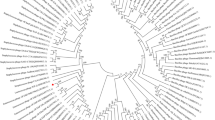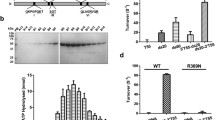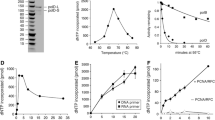Abstract
A DNA fragment from phage ΦU1 containing an origin of DNA replication was identified. This fragment, designatedori, was able to support the maintenance inStreptomyces lividans of a plasmid lacking a functional Gram-positiveori. The sequence of the minimalori fragment was determined and analyzed. The minimal fragment conferring replication origin function contained a number of direct and inverted repeats. The absence of an open reading frame in thisori fragment indicates that host factors alone were sufficient to initiate replication atori.
Similar content being viewed by others
References
Birnboim H.C., Doly J.: A rapid alkaline extraction procedure for screening recombinant plasmid DNA.Nucl. Acids Res. 7, 1513–1523 (1979).
Both V., Hebert E.J., Homerova D., Jucovic M., Nazarov V., Rybajlak I., Sevcik J.: Barstar inhibits extracellular ribonucleases ofStreptomyces and allows their production from recombinant genes.Protein Peptide Lett. 3, 225–231 (1996).
Bruton C.J., Guthrie E.P., Chater K.F.: Phage vectors that allow monitoring of transcription of secondary metabolism genes inStreptomyces.Biotechnology 9, 652–656 (1991).
Chater K.F.:Streptomyces phages and their applications toStreptomyces genetics, pp. 119–158 in S.W. Queenes, L.E. Day (Eds).The Bacteria: a Treatise on Structure and Function, Vol. 9, Antibiotic-Producing Streptomycetes. Academic Press, New York 1986.
Dmitriev A., Tkáčiková L', Suvorov A., Kantíková M., Mikula I., Totolyan A.: Comparative genetic study of group B streptococal strains of human and bovine origin.Folia Microbiol. 44, 449–459 (1999).
Gaudreau L.R., Dery C.V.:http://www.ncbi.nlm.nih.gov:80/entrez/query.fcgi?cmd-retrieve&db=nucl otide&list_uids=532724&dept=genBank. Nucleotide GeneBank M97363 (1994)
Godány A., Farkašovská J., Ziffová M., Bukovská G.: Transfer of plasmid DNA by streptomycete phage ϕU1.Biologia 56, 257–261 (2001).
Herman-Antosiewicz A., Rutkowska S., Taylor K., Grzegorz W.: Replication and maintenance of plasmids devoid of the Cro repressor autoregulatory loop inEscherichia coli.Plasmid 40, 113–125 (1998).
Hopwood D.A., Bibb M.J., Chatek K.F., Kieser T., Bruton C.J., Kieser H.M., Lydiate D.J., Smith C.P., Ward J.M., Schrempf H.:Genetic Manipulation of Streptomyces.A Laboratory Manual. John Innes Foundation, Norwich (UK) 1985.
Howe C.C., Smith M.C.: Gene expression in thecos region of theStreptomyces temperate actinophage phiC31.Microbiology 142, 1357–1367 (1996a).
Howe C.W., Smith M.C.: Characterization of a late promoter from theStreptomyces temperate phage PhiC31.J. Bacteriol. 178, 2127–2130 (1996b).
Jakimowicz D., Majka J., Messer W., Speck C., Fernandez M., Cru-Martin M.: Structural elements of theStreptomyces oriC region and their interaction with the DnaA proteins.Microbiology 144, 1281–1284 (1998).
Kendall K.J., Cohen S.N.: Complete nucleotide sequence of theStreptomyces lividans plasmid pIJ101 and correlation of the sequence with genetic properties.J. Bacteriol. 170, 4634–4651 (1988).
Kieser T.: Factors affecting the isolation of cccDNA fromStreptomyces lividans andEscherichia coli.Plasmid 12, 19–36 (1984).
Kinner E., Pocta D., Stroer S., Schmieger H.: Sequence analysis of cohesive ends of the actinophage RP3 genome and construction of a transducible shuttle vector.FEMS Microbiol. Lett. 118, 283–289 (1994).
Kobler L., Schwertfirm G., Schmieger H., Bolotin A., Sladkova I.: Construction and transduction of a shuttle vector bearing thecos site ofStreptomyces phage ΦC31 and determination of its cohesive ends.FEMS Microbiol. Lett. 78, 347–353 (1991).
Marino T., Takahashi H., Saito H.: Construction and characterization of a cosmid ofStreptomyces lividans.Mol. Gen. Genet. 198, 228–233 (1985).
Myers C.R., Myers J.M.: Replication of plasmids with the p15A origin inShewanella putrefaciens MR-1.Lett. Appl. Microbiol. 24, 221–225 (1997).
Pilipčinec E., Tkáčiková L'., Naas H.T., Cabadaj R., Mikula I.: Isolation of verotoxigenicEscherichia coli O157 from poultry.Folia Microbiol. 44, 455–456 (1999).
Sambrook J., Fritsch E.F., Maniatis T.:Molecular Cloning: a Laboratory Manual, 1st ed. Cold Spring Laboratory Press, Cold Spring Harbor 1982.
Yokoyama E., Matsuzaki Y., Doi K., Ogata S.: Gene encoding a replication initiator protein and replication origin of conjugative plasmid pSA1.1 ofStreptomyces cyaneus ATCC 14921.FEMS Microbiol. Lett. 169, 103–109 (1998).
Author information
Authors and Affiliations
Rights and permissions
About this article
Cite this article
Farkašovská, J., Godány, A., Bukovská, G. et al. An origin of DNA replication from streptomycete phage ΦU1. Folia Microbiol 46, 483–487 (2001). https://doi.org/10.1007/BF02817990
Received:
Revised:
Issue Date:
DOI: https://doi.org/10.1007/BF02817990




